Wayne Harrison specializes in designing training sessions that develop game awareness and quick thinking. A former Academy Director at Blackpool F.C. in the English 2nd Division, he now writes and presents at coaching symposiums worldwide. Harrison holds the prestigious UEFA ‘A’ License as well as a bachelors degree in applied physiology and sports psychology. Several of his books are currently in print through Reedswain and are recommended reading at coaching courses worldwide.
Download PDF Version of Article
THE AWARENESS COACHING METHOD FOR SOCCER
A PSYCHOLOGICAL APPROACH TO THE GAME
Developing Anticipation, Imagination, and “Awareness” in Your Players using the Awareness Coaching Method
The Awareness process is having an awareness (an understanding) of all options available “before you get the ball” and looking ahead of the ball (and getting the feet right to receive the ball), and once you get it to make the correct decisions based on this prior and ongoing information. This is designed to help the player keep possession more easily and not get caught and lose it.
Possession of it can then be broken down into “possession with few touches” (which is epitomized by the way Arsenal in England plays the game using lots of one and two touch plays) and possession with many touches (such as dribbling or running with the ball). This awareness before possession of the ball includes keeping the head up whilst about to control the ball, knowing where team mates are, where opponents are, where the spaces are, but at the same time keeping an eye on and possession of the ball.
On the other hand once the player has the ball, if they decide the right option is to dribble or run with this and thus maintain possession of it themselves with more touches, then that brings in another type of awareness which is that of what to do during possession and the ensuing maintenance of the ball, as opposed to an awareness of what to do with it before receiving and as they receive it. Learning all types of awareness takes a lot of work, practice and training.
We can further break down awareness to that “On the Ball” and also that “Off the Ball”.
“On the Ball” signifies the player about to receive it or who has just received it, “Off the Ball” refers to all the other players who are not directly involved in possession of the ball, yet, basically the other 10 players on the field but particularly those around and close to the ball who may be in the best positions to help the player on the ball. They need to be moving into good open space to help the player about to receive the ball to help them keep possession by moving it on quickly if that is the required decision.
So 4 areas of awareness; On the Ball Awareness before receiving, On the Ball awareness as the player receives it and moves it on quickly using 1 or 2 touches only; On the Ball awareness if the player keeps it using several touches; and “Off the Ball”, awareness of players getting open early to help the player On the Ball. This works if all players are in synch and thinking ahead of the ball and not just the player on the ball.
Our focus here in this clinic is mainly Awareness On the Ball with few touches on it (the beautiful way Arsenal in England play for example), moving the ball on quickly with one or two touches and being able to psychologically think ahead and identify the next correct pass to keep possession. We will finish the clinic by combining “Awareness On the ball with few touches” and Awareness “Off the ball” with two fast moving themed games to link the two.
We are trying to establish the following in the players make up:
A. WHAT they do? (The technique or skill used; and what are the options to move or pass the ball depending on the position on the field of play).
B. WHERE they do it? (Position on the field can dictate this in the decision making process).
C. WHEN they do it? (The timing of the technique or skill used).
D. HOW they do it? (The selection of the technique or skill used).
E. WHY they do it? (The tactical objective).
F. What is the END PRODUCT?
This clinic is presented by Wayne Harrison, Director of Coaching for Eden Prairie Soccer Club these past 7 years, in Minnesota, USA. An UEFA “A” licensed coach, Wayne played professionally for Blackpool F.C. and in Finland for Oulu Palloseura and previously served as the Director of Coaching for the Blackpool Football Club’s “Center of Excellence for Youth”. In addition, he has Head Coached for a number of high level semi-professional teams in England, including Accrington Stanley F.C., Bamber Bridge F.C., Lancaster City F.C.; Workington Reds F.C. and Carlisle United F.C with their Academy. You can write to him at [email protected] There is a book: “Recognizing the Moment to Play” written by Wayne that teaches this Awareness Training, available from www.Reedswain.com. Wayne has 4 books published in total which are all shown here.
Coaching Style:
The Coaching Style will be of a Command Nature due to the clinic situation with new players and a limited time to do the clinic, but Question and Answer and Guided Discovery styles will be used where we are able.
Introduction
I first got the idea of this type of training when Alan Ball, (for the older ones amongst us who will know of him), whom I played with at Blackpool Football Club in England when he joined us as player – head coach as he was winding down his career. Alan Ball was a World Cup winner with England in 1966 playing 72 times for his country and who had a distinguished career in England. He epitomized the one touch play this type of training develops, rather like Paul Scholes of Manchester United, Fabregas of Arsenal, and Alonso of Liverpool do today. Bally actually used to say he only needed HALF A TOUCH!! I believe him having seen him play if there is such a thing!!
The fact no one could get near him (because by the time you had closed him down the ball had gone) and he rarely lost possession in games or in training even at 37 years old at the time proved that.
Alan Ball was my inspiration for this method of play, as was Eric Harrison who is referenced to later.
It has never been more important in soccer to be able to be good at this type of play as the game continues to get faster and faster at all levels of play so decision making has to be faster too.
So, based on their simple concepts, I have developed the idea further that had lead to a book on the topic (Recognizing the Moment to Play) and this coaching clinic.
A new book on the topic will be available soon with Reedswain covering 50 training sessions on Awareness.

Reedswain Testimonial for the book
This unique coaching program focuses on the development of each player’s soccer instincts: (Anticipation, Imagination, and Awareness) through the use of specially designed training sessions. While this is quite possibly the most important aspect of a players soccer development, it is also the most difficult to coach. In this book, the author provides many practical exercises and small sided games to help players Recognize the Moment to Play.
THE DECISION MAKING THOUGHT PROCESSES THE PLAYER IS GOING THROUGH AT ANY ONE TIME IS AS FOLLOWS:
1. OBSERVING WHERE THE BALL IS COMING FROM.
2. OBSERVING HOW THE BALL IS COMING.
3. KNOWING WHERE THEIR TEAMMATES ARE.
4. KNOWING WHERE THE OPPOSITION PLAYERS ARE.
5. DECIDING “WHAT” SHOULD THE PLAYER DO WITH THE BALL. THE TECHNIQUE / SKILL TO USE (EMPHASIS ON A GOOD FIRST TOUCH) – PASS, RUN, SHOOT, CROSS, DRIBBLE, DUMMY / LEAVE. (NARROW THE LIST OF POSSIBLE OUTCOMES FROM ALL AVAILABLE OPTIONS).
6. OBSERVING “WHERE” TO PLAY THE BALL. (ASSESS OPEN SPACES AND SUPPORTING OPTIONS ON THE FIELD).
7. DECIDING “WHEN” TO PLAY THE BALL. (TIMING OF THE TECHNIQUE / SKILL USED).
8. DECIDING “HOW” TO PLAY THE BALL. (SELECT A SPECIFIC SKILL TO USE).
9. DECIDING “WHY” A GIVEN CHOICE IS BEST. (COMPARE ALL OPTIONS WITH THE TEAM’S TACTICAL OBJECTIVES).
PROGRESSION 1
DEVELOPING AWARENESS IN POSSESSION OF THE BALL THROUGH A FUN POSSESSION GAME WITH A BALL EACH
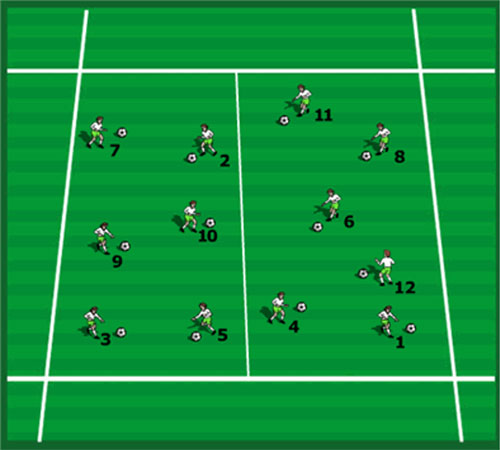
This is a good Warm Up
1. Each of 12 players has a ball to play with. They must protect their own soccer ball but at the same time try to kick someone else’s ball out the area. When your ball is kicked out you cannot kick anyone else’s ball out. You can vary the game by allowing them chances, maybe up to three each before they are ultimately out of the game. When they are out have them juggle the ball to keep practicing skills.
2. Play until the last player is left with their own ball still and everyone else’s ball has been kicked out. This player is the winner.
3. Variations can be you have three areas of play they can work in. They start in one then if they are kicked out they go to the next and so on, this way they get two chances but also you can have two winners in each group with an overall winner at the end. Or you can just decrease the area they are playing in to make it harder as there is less space to work in.
4. Coaching Points
a) Awareness of where other players are whilst maintaining possession of the ball ensuring players are looking around away from their own ball not just down at it.
b) Dribbling and Turning,
c) Shielding,
d) Tackling,
e) Anaerobic Fitness work.
This is a practice that is fun but ensures relevant skills are practiced by the players.
PROGRESSION 2
A GAME WORKING ON AWARENESS IN POSSESSION OF THE BALL
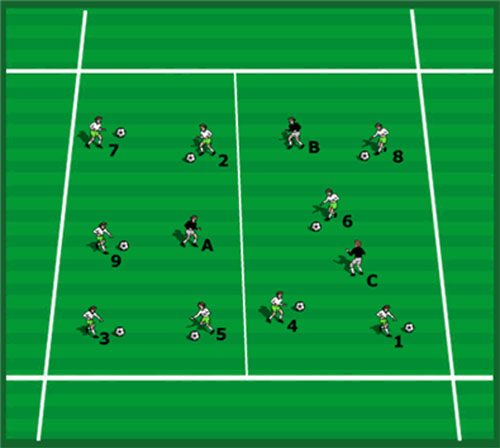
1. There are 12 players in this clinic (it can be any number), 9 with a ball, 3 without. The 3 players without a ball have to try and win a ball off a player with a ball and pass it to the coach. If a player has lost their soccer ball then they can join in with the other players helping them keep possession by passing and support play.
EMPHASIZE LOOKING AROUND, LOOKING OVER THE SHOULDER.
2. To make this competitive rotate the players so different groups of 3 work together, time each group to see who does this in the quickest time.
3. This represents winning the ball and keeping possession in a game, rather than kicking it out of play and losing possession again in a game.
4. The session develops from an individual 1 v 1 attacking / defending work out to a passing and support situation. You can work on the defenders by encouraging them to work as a team, maybe in 2’s for instance to have a better chance of winning the soccer balls. The defenders can pass the ball around between themselves until one can find the coach with a pass. Attackers during this time can try to win it back before it goes out the area and keep possession.
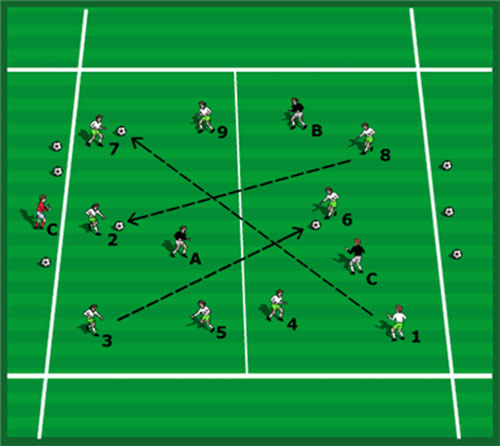
1. This is showing the progression of the session where the defenders have won 6 balls and got 3 to the coach thus maintaining possession if it were likened to a game.
2. Coaches can move around so the players have to have an awareness of where the coach is to pass to.
3. Coaching Points
Attackers with the ball –
a) Dribbling and turning practice,
b) Shielding the ball,
c) Moving and support play,
d) Quality of passing, players keep possession by passing between each other once one or more lose their ball.
e) Awareness of positions of both sets of players and where the spaces are.
Defenders without the ball –
a) Practicing defensive pressurizing skills,
b) Team work (in 2’s or more) to win the ball using supporting defensive skills – Angle / Distance / Communication,
c) Maintaining possession after winning the ball,
d) Awareness of the player to pass to (the coach or a team mate to get it to the coach),
e) Quality of the pass once they win the ball.
4. The essence of this game is it is fun and competitive for the players but it also provides a situation where they are learning important skills.
5. Every ball won by a defender must be passed to the coach to show they have won the ball but also kept possession of the ball. This teaches the players the importance of not just winning possession of the ball but also trying to maintain possession after winning it. If the defending player passes the ball to the coach and it is not accurate and does not get to the coaches feet then the attacker who had the ball gets it back to continue in possession. This ensures quality of passing from the defender who has won back the ball in the first place.
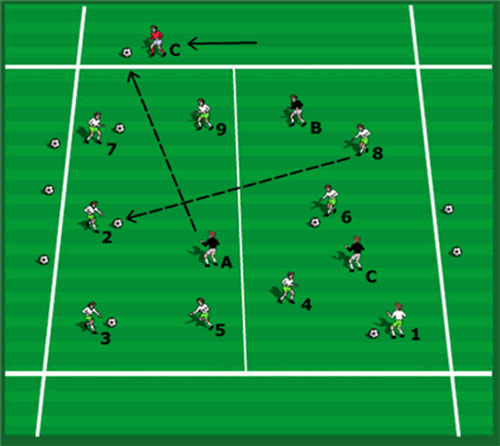
6. Develop – Make it a two team game, one defends, one attacks, time each team as to how long it takes for them to win possession of each ball and make a successful pass to the coach. The clock stops when all the 6 balls have been passed successfully to the coach.
7. Now defenders need to have awareness too as when they win the ball they need to know quickly where the coach is to pass the ball to and consequently be successful. So, whilst they are defending trying to win the ball they are also watching the coach in their peripheral vision to see where he or she is.
PROGRESSION 3
DEVELOPING AWARENESS “BEFORE” RECEIVING THE BALL: TWO TEAMS PLAYING “THROUGH” EACH OTHER
Divide the players into two teams, a ball each team, passing and moving in the same area passing through each other, but not playing against each other. Each team can’t take the other team’s ball.
This is an incredibly simple exercise but one I watched a famous Youth coach, Eric Harrison at Manchester United do many years ago at an FA Symposium with Beckham, Scholes, the Neville’s and Ryan Giggs to name a few famous players he developed through the youth academy. He told us he used this for his warm up every day to develop his player’s awareness on and off the ball.
Technical/Tactical Design
Lots of touches on the ball are achieved in this practice.
a) The players must play with their heads up (so they view what is around).
b) Look over the shoulder before receiving the ball.
c) Body stance open to receive the ball.
d) Move the ball on the 1st touch away from pressure and into space or towards where you are passing it or one touch transfer if that pass is on.
e) Awareness of teammates positions on the field in advance.
f) Awareness of opponents positions on the field in advance.
g) Passing to space to move players into a better position on the field
h) Passing to feet.
i) Turns / dribbles / 1t / 2t, free play.
j) Communication (key words).
k) Support Angles / distances to help the player on the ball.
Develop
a) Increase the number of soccer balls per team.
b) Pass to opposite colors. Below we have several balls being passed.
c) Progress to an overload game, for example 3 v 3 v 3, before going to an equal numbers two team game of possession.
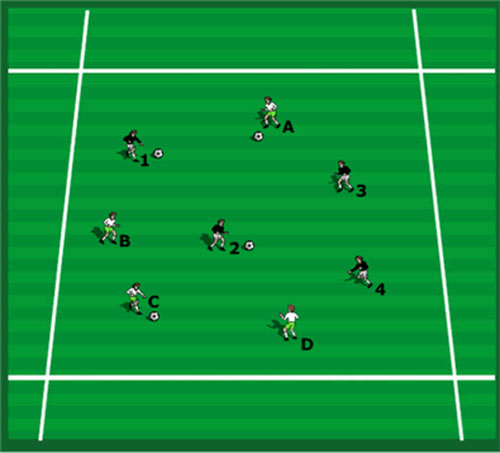
PROGRESSION 4
IMPROVING AWARENESS “BEFORE” RECEIVING THE BALL THROUGH A SIMPLE NUMBERS CONDITIONED GAME
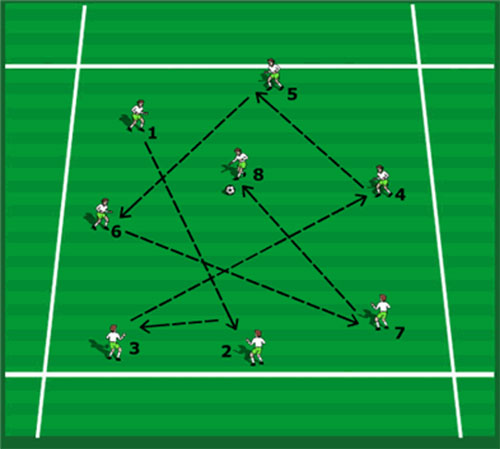
1. The numbers game FORCES the players to look before they receive by the very condition placed on them.
There are 6 Players and only 1 ball to begin. Players must pass in sequence i.e. 1 passes to 2; 2 passes to 3; 3 to 4 and so on to 6 who passes to 1 and we begin again. You can have player’s static to begin as easy introductions to the theme then have them passing and moving. In a roster of 12 players 2 groups of 6 can do this in different areas separately to begin.
2. Player receives from the same person and passes to the same person each time. This develops great awareness of time, space and player positions. This is continuous work on and off the ball. Awareness of: where the player you receive from is and where the player you pass to is. Because of this players begin to anticipate the pass to them and where it is coming from. Also they must look to where it is going to (where is the player they are passing to?).
3. We are trying to create a situation where players are looking two moves ahead not just one. For instance as (1) is about to pass to (2), (3) should be looking to support (2) for the next pass already, looking two moves ahead before the ball leaves (1). Likewise, (2) should already know where (3) is to pass to.
4. Peripheral Vision Development results from this.
5. Develop: Use two balls then three balls at the same time. Start with a ball at (1) and (5) then at (1), (4) and (6).To keep the sequence going players must move the balls quickly with few touches hence their peripheral vision development improves dramatically. As soon as they have passed one ball off the next one is arriving so quick thinking is needed to make the correct decisions.
6. Coaching Points:
a) Awareness of where the player to receive from is before receiving the pass
b) Getting into position to help the passer make a successful pass
c) Awareness of where the player to pass to is before receiving the pass
d) Open Body position to receive the pass to enable a resulting one touch pass if necessary.
PROGRESSION 5: SEMI – COMPETITIVE AWARENESS NUMBERS GAME: PASSING IN SEQUENCE
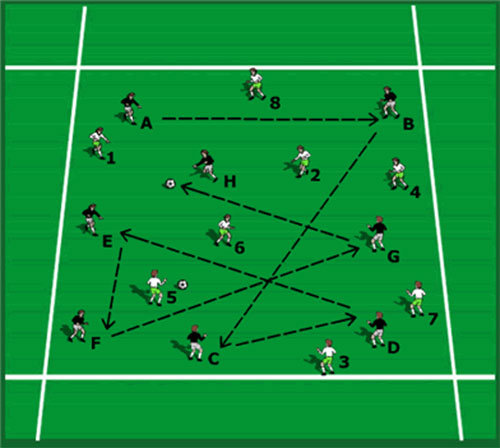
1. Now have 2 teams passing separately 1 to 6 in “each team”, with a ball each team in the same area. The example shows the passing of the numbers team, of course players will be moving but for the simplicity of the idea I show it this way.
2. Develop:
Count the number of passes each team get in a certain time frame adding a competitive element to the game. Who can get the highest number of passes made in a given time frame?
3. Emphasize:
a) Movement “off” the ball to open up angles for passes between other players.
b) Communication verbally between players to help them identify where they are; passing player can call who they are passing to, receiving player can ask for the pass.
c) Ensure players spread out throughout the area to have them playing both long and short passes.
d) Encourage fewer touches on the ball at each reception to move it around the field more quickly helping players develop good transitional play. The actual game is played so quickly now they have to develop this talent as well as having good individual dribbling and turning ball skills.
PROGRESSION 6
WORKING ON PERIPHERAL VISION “BEFORE” RECEIVING THE BALL THROUGH THE SPECIFIC PERIPHERAL VISION COACHING GAME
A 40×30 area is organized as shown in the Diagram below. Six players are used within the activity. Repeat the setup to accommodate the entire team.
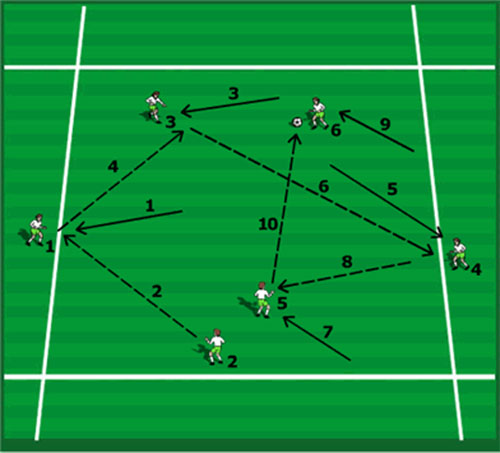
This is a simplified set up to get initial understanding. Increase numbers as previously e.g. two teams of six. We started earlier with one ball and six players for example so each person on the ball had five choices of pass to make and that was easy.
Now we must identify one and only one pass and must try to make it. That pass is to the person who runs outside the zone. This player is the free player (unmarked). The session goes as follows and numbers are used only as a reference only, the players can pass to anyone, in any order, but always looking for that vital run by a player to the outside area:
1. Player (1) runs outside the area (perhaps after several passes within the zone).
2. Player (2) on the ball sees the run and must pass to (1).
3. As (1) is about to receive (as the ball is traveling to him or her) (3) moves into a position to support (1) showing anticipation and awareness.
4 (3) has already seen the run by (4) and passes. (4) Brings the ball back in and the game continues, (4) passes to (5) who has moved into position in anticipation and (5) passes to (6) who also has done the same. This is an indicator of how quickly players recognize the run and consequently make the pass.
5. Hence players are beginning to look one and two moves ahead of the ball. It doesn’t need to happen so quickly in terms of the next player running outside but it serves as an example. The run can be likened to a penetrating run into the attacking third where the player hasn’t been picked up or tracked and is in a great position to attack and score if the passer sees them and makes that pass.
6. Coaching Points:
a) Decision: Movement of the player running out of the area to initiate the move
b) Observation of this movement or run by this player by the other players
c) Observation by the one player receiving the pass as this movement of a run outside the area is taking place
d) Decision by this player to make the one pass they need to the outside player
e) Quality of Passing: A one or two touch pass to the outside player for speed of action to show the run was spotted
f) Weight of pass to the next passing player so they have the choice of making a one touch pass if they have seen the run
g) Observation of the receiving player on the outside of the runs of others to receive the next pass
h) Support Positions: Other players already making movements to help the receiving outside player have options to move the ball quickly with good support in terms of angles, distances and timing.
SPECIFIC PERIPHERAL VISION COACHING SESSION
Further development, ideas and ideals of this practice leading to the introduction of defenders as opposition but in an attacking overload situation.
1. Within the zone there are many choices of pass but as soon as a player makes the run outside that is the pass to make. Coach can determine the tempo of the game e.g. to avoid too many running out at the same time the coach can signal to an individual player to move out without the others knowing so only one at a time goes out.
2. Once the free player is outside and waiting for a pass see how many passes are made inside the zone before someone sees the right pass i.e. to the outside player. This is an indication of which players play with their heads up (and hence have good peripheral vision) and which don’t, (hence have poor peripheral vision or even none at all).
3. The fewer touches on the ball the player needs to get the ball there the greater their anticipation of the run. (One touch is the ultimate aim to develop where as the ball is traveling to the player, at the same time another player makes their run out; they see the run and make the pass at the same time).
4. More touches means more reaction time needed and in a game situation this may mean the player being caught in possession before they get around to making the pass.
5. Initially the coach may see several passes made within the area whilst a player stands and waits outside until someone sees them; this will happen less and less as you practice and as the players improve their peripheral vision.
6. The exciting part of this is when the coach sees one of their players make the right pass quickly in a game situation due to the work they have done in this session.
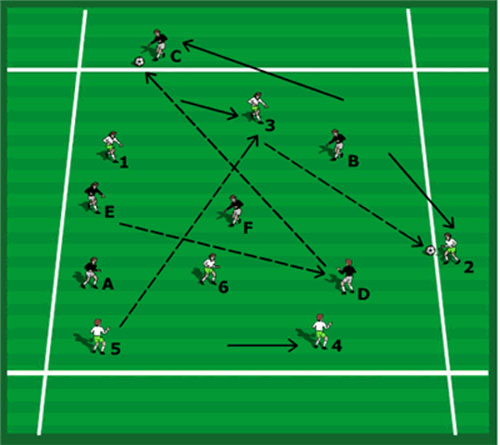
1. Here we have two teams playing in the same area, player (5) passes to player (3). Player (2) as the ball is traveling runs outside the area, player (3) has to see this movement and make the next pass to that player. If (3) makes it with a one touch pass that is excellent as it shows they have seen the run as the ball is arriving and made the quickest pass possible to get the ball to (2). Player (2) then brings the ball back into play and the passing sequences start again.
2. Likewise player (E) on the other team passes to player (D), player (C) runs out of the area and the set up continues.
PROGRESSION 7
GAME SITUATION
(WE WILL USE A 2 TEAM GAME HERE FOR EASE OF TRANSITION BUT AN OVERLOAD THREE TEAM GAME CAN OFTEN BE A BETTER PROGRESSION MOVING TO THE TWO TEAM GAME EVENTUALLY).
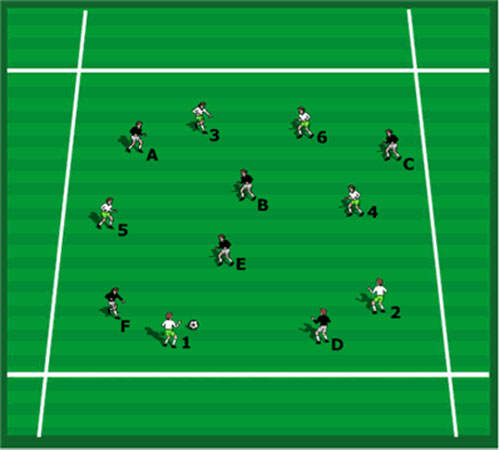
1. A two team game for ease of transition in this clinic with limited time (you can use neutral players to make it easier to work initially it is always best to begin with an overload situation to help them make it work). Five passes a goal.
The winner is the team who scores the most 5 pass – goals, you may do the first to score ten goals.
2. Develop: Include running out of the area in the game and if a player does this and receives a pass successfully they get three goals for it. Defending players can’t track them outside the area.
3. This will encourage players to make outside runs as there is a reward and it will also test the players on the ball as to their peripheral vision and how quickly they identify that particular run. This must happen in less than 6 seconds though and if after a short time the player does not receive a pass then they come back into the game.
4. Player (3) makes a run out of the area as (1) passes to (2). (2) Sees the run and passes and scores 3 goals. (3) Brings the ball back in and the game continues.
5. You are looking for players to anticipate where (3) needs support and move into position to help.
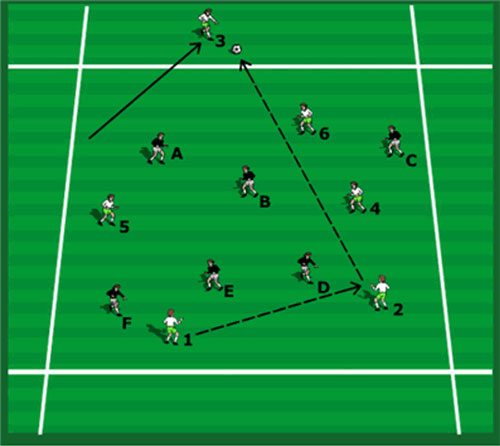
6. Other players need to move off the ball to get into open positions for the first pass or in anticipation of the next ones.
7. You can also reward a one touch pass with a goal to encourage quick play..
PROGRESSION 8
TEACHING AWARENESS AND MOVEMENT “OFF THE BALL” THROUGH THE TRANSITION DIRECTIONAL TARGET GAME
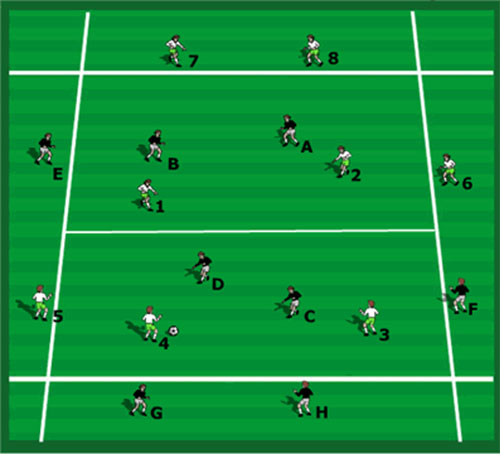
1. Rules:
a) Players must pass the ball to their target players to score. To score again they have to work the ball back into their own half of the field to be able to return.
b) Target players have two touches as do side players.
2. Coaching Points:
a) Creating Space by running off the ball to receive or to help a teammate receive.
b) Quality of Passing; long and short to targets and to teammates.
c) Support play: working angles and distances incorporating switching play using the side players.
d) Receiving and Turning in tight situations and dribbling in 1 v 1 situations.
e) Quick decision making is required in this session because the numbers are small, the area tight and the transitions rapid.
3. Develop:
a) No restriction on touches then 3, 2 or 1 touch, but only if it is on to do one touch.
b) All outside and target players have one touch only where possible
c) switch with target players as they receive the ball.
d) Switch with outside players
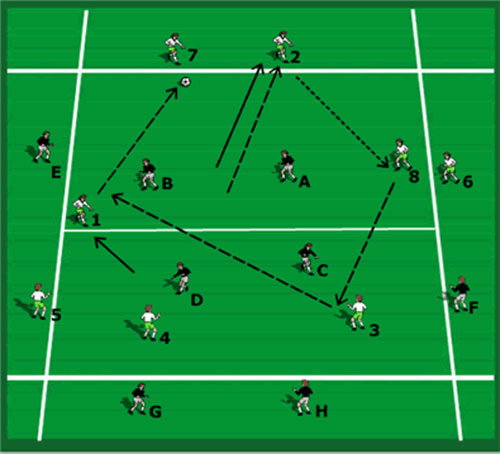
1. Here is an example of the transition and movement off the ball to make it happen.
2. (2) passes to target player (8) who brings the ball back into the playing area.
3. (3) makes a run into the other half of the field on the blind side of (C) to receive the next pass. They need to get the ball into that half to be able to score.
4. (1) makes a forward run into space to receive the next pass off (3) and passes to target player (7) who can start the play again.
5. (1) switches with (7) and becomes a target player for the next phase of play.
6. Observe the Attacking Team – Recognize their movement off the ball for example to work the ball into their own half see if the players make runs early in there as soon as the ball is at a target, some should support short and some long so the target has choices.
7. Observe the Defending Team – see if they are sucked to the ball or they recognize runs off the ball and track players making runs away from the ball into the other half.
8. To lessen the workload and keep everyone involved have players switch with targets and outside side players when they pass to them.
9. Elements of play the target game teaches
Attacking as Individuals and as Team
a) Creating Space by running off the ball to receive or to help a teammate receive.
b) Developing quick support play working angles and distances incorporating switching play using the side players.
c) Passing long and short to targets and to teammates.
d) Receiving and turning in tight situations and dribbling in 1 v 1 situation’s.
e) Lots of touches on the ball for the players in this practice.
f) Quick decision making is required in this session because the numbers are small, the area tight and the transitions rapid.
Defending as Individuals and as a Team
a) Pressurizing players on the ball to regain possession.
b) Supporting pressuring players and tracking runners off the ball.
c) High pressure to regain possession in the attacking half to be able to go straight to the target to score. Transitions from defense to attack and attack to defense, quick decision making and improved concentration as the switch occurs. Interchanges of positions between inside players, targets and side support players.
As a coach you can work in this session how to defend properly as individuals and a team or how to attack properly as individuals and a team.
Conditions to impose to change the focus of the game
1. No restriction on touches then three, two or one touch but only if it is on to do so.
2. Introduce neutral player so a 5 v 4 overload in the middle if possession isn’t kept easily.
3. Interchanges of players outside to in, inside to out as they pass the ball observing the quality of the pass and the first touch of the receiver or performing a crossover.
4. Have one teammate at each end so you are attacking both ends but once you have passed to one target you keep possession and must try to get to the other target. You can’t go back unless the opposition win the ball and then you get it back, only then can you go back to the same target.
5. To lessen the workload and keep everyone involved have players switch with targets and outside players when they pass to them. This causes a constant transition of players and focuses the player’s concentration.
6. The team can only score if they get an overlap, crossover or 1 – 2 in during the build up.
7. No talking so players have to rely on their own vision to play.
8. Players move into the target zone to receive (timing of run and pass) so we don’t play with actual targets, different players can then become the target player.
9. Man – Marking – Have the players man mark so they must track a player when they haven’t the ball and they must lose their marker when they have the ball. This is a good test to see who is working hard and who isn’t as they have a designated job to do. You as a coach can see who works to get free of their marker and who works hard to prevent the player they are marking get the ball.
10. This session is particularly good as a midfield play practice session as you can liken the start when the ball is at a target as it being a target defender passing it in and to get to the other side through midfield to the other target who is now a striker. Then this target player maintains possession and the team can go the other way, the target striker then becomes a defender for the attacking team starting the move and the other target becomes the striker to pass the ball to. So it is consistent movement end to end with the attacking team from a defender into midfield to a striker.
11. To improve the speed of thought reward a successful one touch pass with a goal or point. To score a goal by passing to the target player now reward this with three goals or 3 points.
12. The team in possession can pass back to the opponents target players to help keep possession of the ball. Liken this to passing back to the keeper in a game situation.
GETTING IT WRONG DEFENSIVELY AND / OR GETTING IT RIGHT OFFENSIVELY
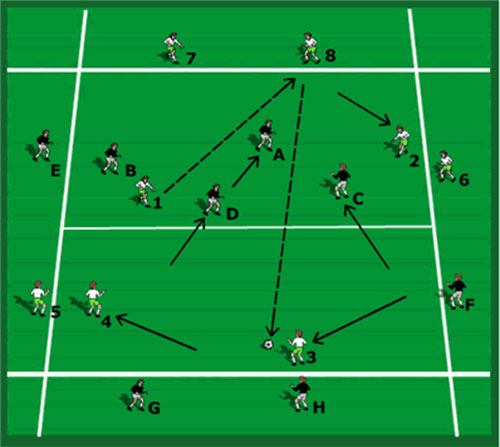
1. This is an example of what to look for on the defending side of things.
2. Here the ball has been passed to the target (8) and a goal scored. The defenders are ball watching and not seeing the runs “off the ball” of their opponents.
3. The idea of getting the ball back into the other half before they can score again when in possession highlights these kinds of moments you need to identify in a game situation.
4. (1) plays the ball to target (8) to score. (2) Supports the next pass short and at a wide angle, and (3) and (4) make runs into the other side of the field and off the ball to get free and receive a pass. Defenders are all ball watching and not looking at these runs and so (3) and (4) get free. At the same time you can say it is getting it right offensively.
5. The coach has to identify these situations and stop the game and show the set up and ask the defending players what they need to do.
Things to Identify and Coach
Offensively
1. Lack of movement off the ball of the players in both halves of the field.
2. Poor quality of the passing.
3. Awareness of the players identifying correct decision making of when and where to pass.
4. Poor Communication to help each other.
5. Poor angles and distance of support and lack of variation of these concepts (long; short and wide are needed so lots of options)
6. Mentally slow change from attack to defense when possession changes.
Defensively
1. Not seeing movements off the ball of the players on the team in possession of the ball and not tracking these runs.
2. Ball watching allowing players to get in behind them.
3. Not pressing the ball quickly enough.
4. Working too much individually and not as a unit.
5. Mentally slow change from defense to attack when possession changes.
PROGRESSION 9
DEVELOPING TEAM PLAY THROUGH A DIRECTIONAL TWO TEAM AWARENESS GAME EMPHASIZING AWARENESS AND MOVEMENT “OFF THE BALL” THUS HELPING THE PLAYER “ON THE BALL”
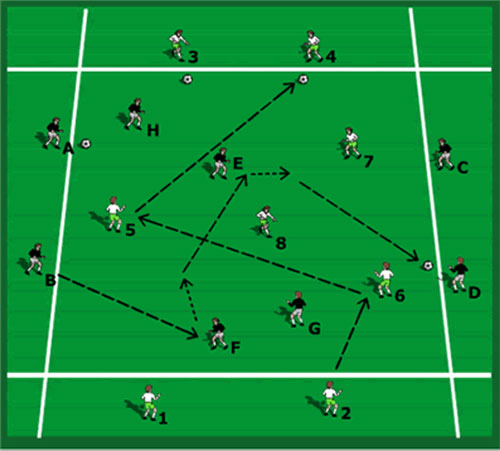
1. Coaching Points:
a) Awareness of where own players are and where the other teams players are before you get the ball
b) Awareness of where the spaces are to move into before you get the ball.
c) Quality of the First Touch: First touch into the path you are taking to get the ball to the outside player or one touch transfer if possible
d) Support positions of teammates off the ball
e) Playing through the other team in the opposite direction testing positional ability
f) Directional movement as in a game
g) Everything done at pace.
2. Example above of playing through the midfield with another inside player to reach one of the targets.
3. Each player takes one touch to take the ball in the direction they want to go and the second touch is a pass to the next player.
4. It may be a one touch pass that is needed depending on the distances involved. It may be they need more touches on the ball because no one is immediately available to receive a pass. Or you may condition it that they need to do a dribble of some sort in the middle before they pass to the next player. There are many variables you can introduce to suit your needs from the clinic.
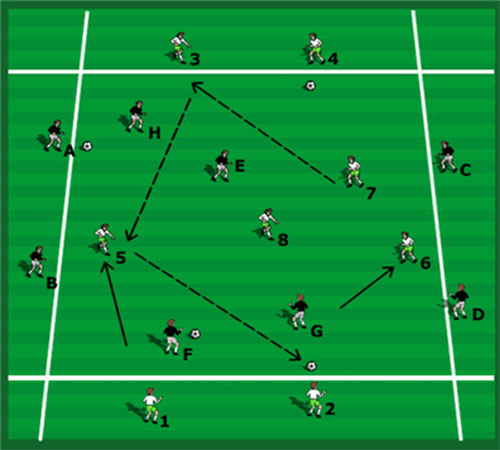
1. Encouraging players to look ahead of the play. Here (7) passes to outside player (3) and another player (5) is supporting (3) for the next pass, working a triangle of support.
2. (3) Needs someone to pass to and to help (3) make a one touch pass quickly, (5) has already moved as shown and got into position to receive and do this.
3. As (5), who is receiving the pass from (3), gets into an angled support position ensuring their body is open, he or she has to have these things in mind before they receive the pass;
a) Where is the space to go to in order to receive the pass from (3)?
b) who is free at the other end to make the next pass to (so is already looking before the ball arrives)?
c) Where is the space to take my next touch (if it open it could be towards the player they are about to pass to), or can I pass it one touch to (1) or (2) on the other side? Here (5) decides to pass to (2) and (6) is already in a position to support (2).
SWITCHING POSITIONS WITH THE OUTSIDE PLAYER
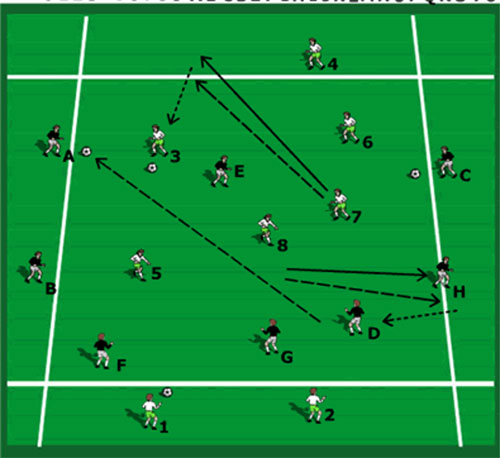
1. Now to involve everyone in the middle have the players switch positions when they
2. Pass to an outside player. (7) Passes to (3), and (3) then takes the ball back in with a good first touch to then look to pass to another player and get the ball to the other side.
3. Likewise (D) receives from (H) and runs the ball into the middle to continue the movement, and (H) runs out of the area to be an outside receiver. (D) Then passes to (A) player and switches with them.
PROGRESSION 10 GAME SITUATION
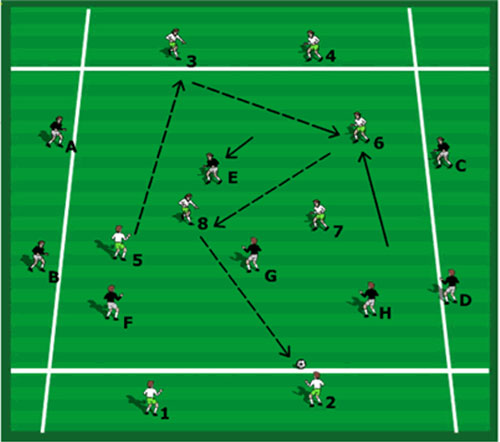
1. Now we take the session into a game. It is a 4v4 game.
2. The inside numbered players work with outside numbered players and score by completing a pass to the outside players. They then have to get the ball to the other side to score again. Inside Letters players work with the outside letters players so teams play in opposite directions.
3. GAME: Play to 10 goals then rotate the players so all players get the chance to play.
4. Rotate the teams.
5. Here the number team have scored one goal at one end then switched the play to the other end by quick and accurate passing to score another goal.
GAME SITUATION SWITCHING WITH OUTSIDE PLAYERS
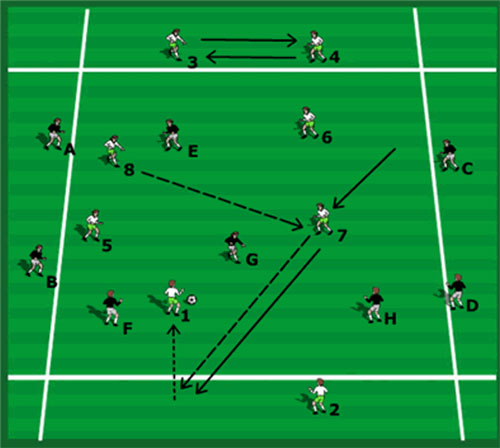
1. Developing the idea with outside players switching with inside players on scoring a goal with a pass.
2. Progression: Introduce scoring a goal by making a successful one touch pass within the game to encourage the players to think quickly and make instant decisions when they receive the ball.
3. Have outside players switching positions so when they receive the pass it is to a moving player and not one stood still. This is more passing to space than to feet, to where the players is going to on the outside as they switch with their teammate.
Conclusion
These are just a few ideas of many ways you can begin to teach your players the essentials of Awareness on and off the ball.
This concept is an increasingly important part of the game that players have to develop and learn to be able to improve their play and better maintain possession of the ball.
